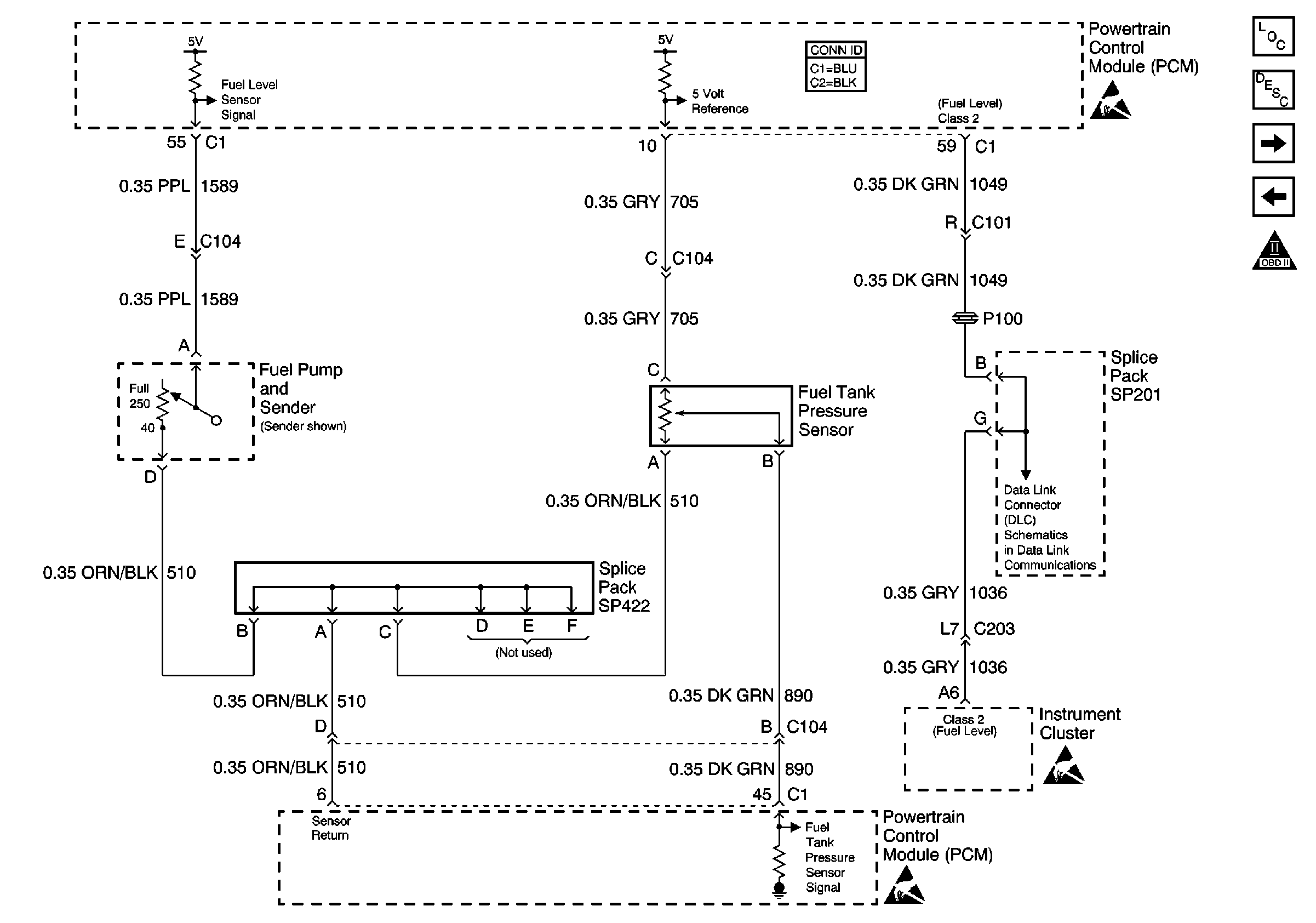Refer to
Fuel Level and Fuel Tank Pressure Sensors

Circuit Description
The fuel tank pressure (FTP) sensor is used in order to detect a vacuum decay or an excessive vacuum during the evaporative emission (EVAP) diagnostic routine. The fuel tank pressure sensor responds to the changes in the fuel tank pressure or vacuum. The signal voltage to the powertrain control module (PCM) varies from a minimum of about 0.2 volts with pressure in the fuel tank to above 4.0 volts with a high vacuum in the fuel tank.
The fuel tank pressure display on the scan tool has an auto zero feature which occurs at each ignition cycle and is corrected according to the barometric pressure. Because of this, the fuel tank pressure may not accurately reflect the actual output of the sensor or the conditions within the fuel tank.
Conditions for Running the DTC
The engine is running.
Conditions For Setting the DTC
The fuel tank pressure sensor voltage is more than 4.9 volts for more than 25 seconds.
Action Taken When the DTC Sets
| • | The malfunction indicator lamp (MIL) will illuminate. |
| • | The PCM will record the operating conditions at the time that the diagnostic fails. The Freeze Frame and Failure Records buffers will store this information. |
| • | A history DTC stores. |
Conditions for Clearing the MIL/DTC
| • | The MIL will turn OFF after 3 consecutive ignition cycles in which the diagnostic runs without a fault. |
| • | A history DTC will clear after 40 consecutive warm up cycles without a fault. |
| • | Use a scan tool to clear the DTCs. |
Diagnostic Aids
Inspect for the following conditions:
| • | Inspect the control module harness connectors for the following conditions: |
| - | Improper mating |
| - | Broken locks |
| - | Improperly formed |
| - | Damaged terminals |
| • | Inspect the wiring harness for damage. If the harness appears to be OK, observe the fuel tank vacuum display on the scan tool while moving the connectors and the wiring harnesses related to the sensor. A change in the display will indicate the location of the fault. |
Refer to Evaporative Emission System Cleaning before starting repairs.
Test Description
Numbers below refer to the step numbers on the diagnostic table:
-
This step will determine if DTC P0453 is the result of a hard malfunction or an intermittent condition.
-
This step simulates conditions for a DTC P0452. If the PCM recognizes the change, that indicates that the following items are OK:
-
This step tests for an open in the fuel tank pressure sensor ground circuit.
-
When the fuel tank pressure sensor signal circuit is shorted to battery voltage, The vehicle will remain in Open Loop, the TP sensor value will read above 0 percent at all times and the A/C high side value will read high on the scan tool.
-
Disconnect all the sensors that use the same 5.0 volt reference circuit one at a time while monitoring the 5.0 volt reference circuit on the scan tool. Test and repair any circuit, or replace any sensor, that changes the scan tool reading of the 5.0 volt reference circuit.
-
The replacement PCM must be programmed and the Crankshaft Position System Variation Learn procedure must be performed.
| • | PCM |
| • | Fuel tank pressure sensor 5.0 volt reference circuit |
| • | Fuel tank pressure sensor signal circuit |
Step | Action | Values | Yes | No | ||||
|---|---|---|---|---|---|---|---|---|
1 | Did you perform the Powertrain On-Board Diagnostic (OBD) System Check? | -- | ||||||
2 |
Does the fuel tank pressure sensor voltage read more than the specified value? | 3.0 V | ||||||
Does the fuel tank pressure sensor voltage read equal to or more than the specified value? | 3.0 V | Go to Diagnostic Aids | ||||||
Does the fuel tank pressure sensor voltage read more than the specified value? | 0.2 V | |||||||
Does the test lamp illuminate? | -- | |||||||
Did you find and correct the condition? | -- | |||||||
7 |
Does the 5.0 volt reference circuit measure near the specified value? | 5.0 V | ||||||
|
Important:: The powertrain control module (PCM) uses a single 5.0 volt power supply to supply power to all the engine control components. If one component shorts its 5.0 volt reference circuit to ground or battery voltage, the other 5.0 volt reference circuits will also have a low or high voltage.
Did you find and correct the condition? | -- | |||||||
9 |
Did you find and correct the condition? | -- | ||||||
10 |
Did you find and correct the condition? | -- | ||||||
11 |
Did you find and correct the condition? | -- | ||||||
12 | Replace the fuel tank pressure sensor. Refer to the Fuel Tank Pressure Sensor Replacement . Did you complete the replacement? | -- | -- | |||||
|
Important: : The replacement PCM must be programmed. Powertrain Control Module Replacement/Programming Replace the PCM. Refer to the . Did you complete the replacement? | -- | -- | ||||||
14 |
Does the DTC reset? | -- | System OK |
